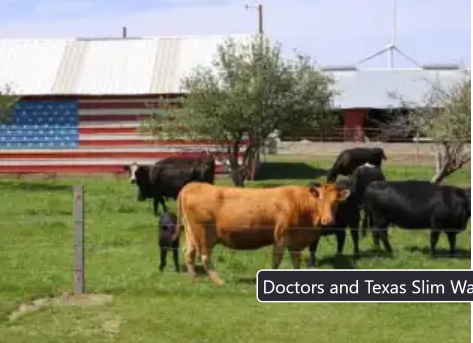Doctors and Texas Slim Warn of GM and mRNA in Our Food and Milk

JOE BIDEN THE FAMOUS BOLD-FACE LIAR
Home of News, Politics & Opinion
Without oversight and transparency, mRNA vaccines and therapeutics are used on animals under a EUA. Some countries are putting mRNA in food, the seed, and cow milk. The food cartel also forces GM foods on us, and they too can cause health and environmental risks. They don’t have to tell us or get our permission. Watch the clip with attorney Tom Renz.
FROM THE DIRT OF TEXAS
First, people might want to read a current article from Texas Slim, posted on Dr. Malone’s substack. Texas Slim addresses GM foods.
The Harvest of Deception can be read at Dr. Robert Malone’s substack, but here is an excerpt from a farmer, a descendant of pioneering families:
The widespread use of GM foods poses significant health and environmental risks that cannot be ignored. The effects of GMOs on human health, cross-contamination, and lack of transparency in labeling are all serious issues that need to be addressed. It is crucial to preserve the natural state of the earth and the nutritional value of fruits and vegetables by avoiding the use of engineered crops that have only been approved for human consumption for a little over 20 years.
The world’s food supply is controlled by just a handful of companies, and the concentration of power in the food industry has increased over time. In the United States, less than 1% of the population is employed in agriculture, and most of the food sold in the country is controlled by a few large corporations.
The food cartel exercises a significant degree of control over domestic agricultural economies, especially in the processing industries. This includes the milling and packing/slaughtering industries, which are controlled by a few large companies. For example, in the case of grains and soybeans, the top four millers controlled 41% of the industry in 1979, and they now control 92%. In addition, four of the six leading grain cartel companies own 64% of America’s grain elevator storage capacity, which means that farmers must sell their grain to these companies, and these firms collude to set the price for the farmer at the lowest possible level.
The food cartel’s power must be broken, as they control the supply of raw materials and above all, food. The food cartel apparently seeks to turn back the clock of history and reduce mankind from the 7 billion population it currently enjoys to the state of a few hundred million semi-literate souls scratching out a bare existence. The full truth about the food cartel must be known, and the extreme globalization of the food chain must be eliminated. Nations have been forced into dependence on food from hundreds and thousands of miles away, and this is not sustainable in the long term.
In conclusion, the food industry’s concentration of power has led to a lack of transparency and control over the world’s food supply. The top seed companies account for two-thirds of the global proprietary seed market, and the top three seed companies control 65% of the proprietary maize (corn) seed market worldwide and over half of the proprietary soybean seed market. The food cartel exercises significant control over the domestic agricultural economies of nations, and the extreme globalization of the food chain must be eliminated to ensure food security in the long term.
The Following Comes from Dr. McCullough and Dr. Malone’s Reports on Substack
“In China, researchers have managed to create an mRNA vaccine for COVID-19 that can be taken orally. To test it, the vaccine was mixed with cows‘ milk and given to mice. The mice were able to absorb the mRNA, which then traveled to their bloodstream and lymphatic tissues, prompting the production of antibodies against the Spike protein of the SARS-CoV-2 virus,” writes Dr. Panda.
Dr. Peter A McCullough nicely summarized a preprint in bioRxiv.
An oral vaccine for SARS-CoV-2 RBD mRNA-bovine milk-derived exosomes induces a neutralizing antibody response in vivo
Dr. McCullough confirms people’s concerns about secret injections of mRNA into the food supply are valid. mRNA technology has just entered a “whole new, much darker phase of development.”
The nation’s food supply can be manipulated by public health agencies to influence population outcomes. A great is example is fortification of cereal grains with folic acid — the synthetic form of folate — which successfully reduced the incidence of neural tube defects (e.g. spina bifida). Now an oral route of administration is being considered specifically for COVID-19 vaccination using mRNA in cow’s milk.
Zhang and colleagues have demonstrated that a shortened mRNA code of 675 base pairs could be loaded into phospholipid packets called exosomes derived from milk and then using that same milk, be fed to mice. The mice gastrointestinal tract absorbed the exosomes and the mRNA must have made it into the blood stream and lymphatic tissue because antibodies were produced in fed mice against SARS-CoV-2 Spike protein (receptor binding domain).
An oral vaccine for SARS-CoV-2 RBD mRNA-bovine milk-derived exosomes induces a neutralizing antibody response in vivo. Quan Zhang, Miao Wang, Chunle Han, Zhijun Wen, Xiaozhu Meng, Dongli Qi, Na Wang, Huanqing Du, Jianhong Wang, Lu Lu, Xiaohu Ge bioRxiv 2022.12.19.517879; doi: https://doi.org/10.1101/2022.
The Success That Could Injure or Kill You
From a scientific perspective, these experimental steps taken by the Chinese were a stunning success. However, given the damage mRNA vaccines have generated in terms of injuries, disabilities, and deaths, these data raise considerable ethical issues. The COVID States project has shown that 25% of Americans were successful in remaining unvaccinated. This group would have strong objections to mRNA in the food supply, particularly if it was done surreptitiously or with minimal labelling/warnings. Children could be targeted with easily administered oral vaccine dosing or potentially get mRNA through milk at school lunches and other unsupervised meals.
For those who have taken one of the COVID-19 vaccines, having milk vaccines as an EUA offering would allow even more loading of the body with synthetic mRNA which has been proven resistant to ribonucleases and may reside permanently in the human body.
The Darker Phase
These observations lead me to conclude that mRNA technology has just entered a whole new, much darker phase of development. Expect more research on and resistance to mRNA in our food supply. The Chinese have just taken the first of what will probably be many more dangerous steps for the world.
Concerns about mRNA in the food supply are nothing new. However, this type of mRNA vaccine that can easily be concealed in milk for human consumption (or anything similar) could be very dangerous. According to the COVID States project, there is a genuine danger of individuals who are either unvaccinated or unwilling to receive additional vaccinations, consuming products that lack proper labeling or warnings.
Currently, in Missouri, there is HB1169 that, if passed, would require disclosure and labeling of foods that contain mRNA ‘vaccines’. We need to see this introduced and passed in more states and countries. Dr. Panda says “You should know what you eat.”
THEY ARE HERE AND HAVE BEEN HERE
We do not know if mRNA vaccines and therapeutics are in the food we eat.
Vaccines and therapeutics – mRNA have existed under emergency use since 2013. Dr. Robert Malone listed some of what we know from press releases and studies.
The website ClinicalTrials.gov allows tracking of drug efficacy studies resulting from approved Investigational New Drugs (including vaccines). The searchable database was made available to the public on February 29, 2000.
Searching for human clinical trials was easy.
No Database for Animals
With animals, there is no such database. The mRNA vaccines in the “animal health” or veterinary markets are difficult to track until the company or the USDA is ready to release information on that product’s development or release. The USDA and/or the NIH have no mechanism for tracking potential new vaccines, drugs or biologics for the animal market.
According to Dr. Robert Malone, all we have are press releases, peer reviewed papers, conference notes, contracts, university websites, and company profiles to discover new products. This is not transparent.
By federal law, the public must have this information.
Dr. Robert Malone Found the Following in the Media as of January
What we do know is that Bayer is partnering with BioNTech to develop mRNA vaccines, and drugs for animal health. The companies said their partnership is the first of its kind focused on developing mRNA therapeutics for animal health applications.
1. Bayer Partners with BioNTech to Develop mRNA Vaccines, Drugs for Animal Health
Bayer, BioNTech developing new mRNA vaccines
Bayer and BioNTech have worked on livestock and companion animal mRNA vaccines for over six years.
There are three therapy platforms that BioNTech has been building through mRNA technologies to be used in livestock and companion animals.
- Infectious disease vaccines
- Cancer immunotherapies and
- Protein replacement.
Bayer to manufacture mRNA vaccine in Germany
Bayer lent their mRNA manufacturing vaccine facilities for the making of COVID-19 mRNA vaccines. Bayer and BioNTech were collaborating to make mRNA vaccines for the animal markets; it would make sense that these facilities were built for the production of veterinary vaccines.
2. SEQUIVITY: Custom Swine Vaccines using RNA vaccines.
Merck is already selling mRNA vaccines for swine. They are selling these products as “customized prescription vaccines against strains of influenza A virus in swine, porcine circovirus (PCV), rotavirus and beyond.” This is an interesting market segment. Merck’s reason for limiting the production of mRNA vaccines in the “customized prescription” market is unclear. Production facility size and scaleability of the RNA product could be factors.
3. Acquisition Expands and Complements Merck Animal Health’s Strong Vaccine Portfolio
Merck Press Release, November 12, 2015, 5:00 pm ET
…
This pioneering system is rapidly adaptable to new disease challenges and was instrumental in producing the first conditionally licensed vaccine to help control Porcine Epidemic Diarrhea Virus (PEDv), a deadly virus that has killed more than eight million piglets since suddenly emerging in the U.S. in 2013.
Sometime before 2015, the USDA issued a conditional license for a mRNA vaccine for use in pigs for Porcine Epidemic Diarrhea Virus (PEDv), information about this product can be found at drugs.com.
Basically, something akin to an emergency use authorization was issued around 2014 or 2015. Just like with the mRNA COVID-19 vaccine, full licensure was not granted but the conditional license remains in place. Is this a strategy to circumvent the USDA vaccine licensing and or authorization process?
To conclude:
Like with the BioNtech’s veterinary mRNA vaccine development, Merck’s development of an mRNA vaccine product started years ago. For Merck, it may have begun in earnest in 2015 with the acquisition of Harris Vaccine.
4. NOVEL MRNA VACCINE TECHNOLOGY FOR PREVENTION OF BOVINE RESPIRATORY SYNCYTIAL VIRUS
IOWA STATE UNIVERSITY (grant summary page)
Non Technical Summary
Bovine respiratory syncytial virus (RSV) is a significant viral pathogens of young cows that is a key component of the respiratory disease complex and often leads to secondary bacterial pneumonia….Our overall goal is to test a novel mRNA system for inducing immunological protection from bovine RSV infection. We hypothesize that a prefusion F mRNA delivered continuously by vaccine implant will lead to prolonged and robust cellular and antibody immunity. Here, we will optimize our vaccine further and then test for potential correlates of protection to examine in eventually challenged cows.
Research into mRNA vaccine livestock vaccines in New Zealand and Australia continues with governmental fast-track approval.
5. NSW fast tracks mRNA FMD and Lumpy Skin Disease vaccines (in cattle)
The NSW Government has taken another step towards fast tracking the world first mRNA vaccines for Foot and Mouth Disease (FMD) and Lumpy Skin Disease, inking a deal with US biotechnology company Tiba Biotech
A Foot and Mouth Disease mRNA Vaccine Deal Has Been Signed Between the NSW Government and US Company Tiba Biotech
Finally, there are mRNA vaccines for COVID-19 for wildlife that have been developed and authorized for distribution by the USDA.
6. Black-footed ferret COVID-19 vaccination seems to be workingThe Wildlife Society, Feb 18, 2021
After finding similar species can be infected, researchers quickly began to increase safety protocols at zoos and the U.S. Fish and Wildlife Service’s National Black-footed Ferret Conservation Center in Colorado, the main source of the captive-breeding and release program for the federally endangered species.
“They have done a magnificent job in keeping those animals safe,” said Tonie Rocke, a research scientist with the USGS National Wildlife Health Center who works with ferrets.
But U.S. Geological Survey researchers who also study black-footed ferrets had learned about recent studies in mice and hamsters, demonstrating safety and efficacy of vaccination against COVID-19 using purified viral protein. They decided to try something similar on a handful of ferrets this past May and June.
The vaccine used in ferrets is different — it’s a simplified version of the Moderna or Pfizer vaccinations now being used for humans — and it’s based on a similar protein, said Rocke.
Under the authority of the USFWS, the scientists could test the solution on a handful of ferrets in a process that is much quicker than the extensive approvals needed for commercial vaccination for humans like the Pfizer or Moderna inoculations.
The isolated ferrets that had received this trial vaccination produced antibodies against the coronavirus.
Again, something akin to an emergency use authorization was issued for this experimental vaccine. Just like with the mRNA COVID-19 vaccine and the RNA porcine vaccine above, full licensure was not granted but it appears that the conditional license remains in place. I raise the question again, is this a USDA and/or corporate strategy to circumvent the USDA vaccine licensing and/or authorization process?
The issue is of course that there is no mechanism for the “right to know” of animal health vaccine development.















